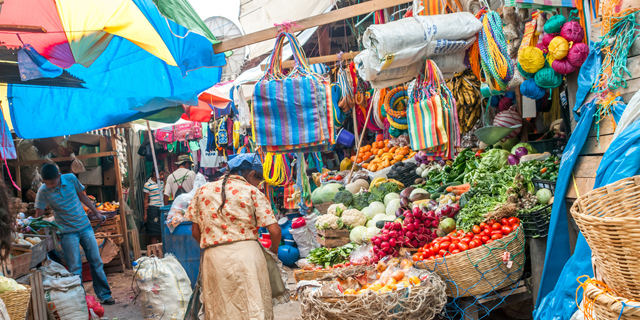Honduras is one of the most unexplored places in Central America. Think of it as Costa Rica 20 (or even 30) years ago. It has extreme levels of biodiversity and is, for the most part, undeveloped.
The most common access point for travelers are the Bay Islands of Roatán, Utila, and Guanaja. These three tiny Caribbean islands are blessed with fine beaches and clear waters with spectacular coral reefs that attract hordes of divers year round. Along with much of the north coast, the cooking here is influenced heavily by the Garífuna culture, a fusion of West African and Caribbean Indians that refused to be enslaved on the island of St. Vincent and were displaced here in 1797. The best Garífuna restaurants are simple, thatched roof eateries, often right on the beach, which utilize ingredients such as seafood, coconut milk, and plantains. The north coast is particularly known for its fruit. Lowland areas are home to pineapple and banana plantations, while coffee and cacao can be found at higher altitudes of the rain and cloud forests.
In the mountainous western side of the country, surrounding the Mayan archeological site of Copán and along the border with Guatemala, the Caribbean influence fades and is replaced by that of the Maya Chortí, descendents of the Maya. Corn is more prevalent here and found in chowders and tamales. Beef, pork, and chicken are generally more common here than seafood. At Lago de Yojoa, on the highway between Honduras’ largest cities of San Pedro Sula and Tegucigalpa, you’ll find a strip of dozens of identical shacks specializing in lake fish, typically fried whole, and served with a side of plantains. Near Gracias, there’s the Ruta Lenca, where tiny colonial villages preserve the crafts and cuisine of the Lenca culture, which utilizes many native herbs and plants.
Three Classic Dishes
The Baleada: Every Central American country has some iconic corn based snack – in El Salvador the pupusa, in Mexico the taco – and Honduras is no exception. Here it is the baleada, in its most basic version a thick corn tortilla is placed on a hot and slightly concave round metal plate (called comal) and smeared with refried red beans (or sometimes black) and fresh cream. It’s sold, most often at nights, at street stalls and markets all over the country, especially in the western regions. In large cities such as Tegucigalpa and San Pedro Sula you’ll find fast food restaurants serving baleadas that come with all sorts of toppings like chicken, avocado, eggs, beef, or loroco.
Tapado: In Garífuna villages along Honduras’ north coast, tapado, sometimes called tapou, is a favorite option. The rich, seafood stew begins by tossing in a pot any seafood that is around – fish, shrimp, conch, lobster, King Crab, or jaiba (land crab) – and mixing it with fresh made coconut milk and green plantains. Herbs and spices like achiote, garlic, basil, cumin, and oregano plus lime are used to help flavor it. An alternative version called tapado de res uses beef instead of seafood, while tapado Olanchano uses pork.
Tamales: Honduras is home to dozens of types of tamales. Some are wrapped in plantain leaves, while others are stuffed into cornhusks. While the Garífuna make a tamal called darasa, which is made from green plantain, Montucas, found all over the mainland, are any tamale with a cornmeal base. Honduran tamales are typically stuffed with chicken, beef, or pork. The dough can be savory or sweet, but is rarely spicy, although various seasonings may be used. They are usually larger than Mexican tamales and usually served on Sunday mornings and festivals.


![Making Mealtime Matter with La Familia: Easy Sofrito [Video]](https://thelatinkitchen.com/wp-content/uploads/2015/10/sofrito-shutterstock__0-500x383.jpg)
![Easy Latin Smoothies: Goji Berry Smoothie [Video]](https://thelatinkitchen.com/wp-content/uploads/2015/12/goji_berry-shutterstock_-500x383.jpg)
















![Fun and Fast Recipes: Fiesta Cabbage Salad [Video]](https://thelatinkitchen.com/wp-content/uploads/2015/11/fiesta_cabbage_slaw-shutterstock_-500x383.jpg)









